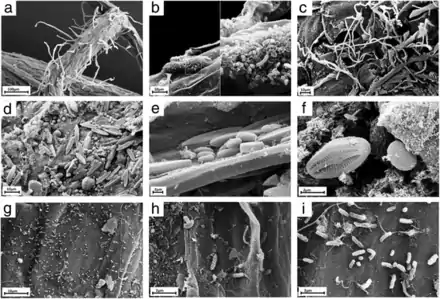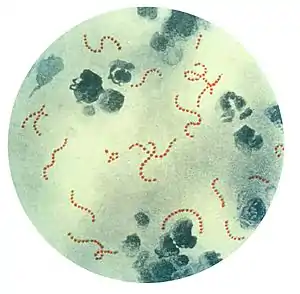Microbial consortium
A microbial consortium or consortium, is two or more bacterial or microbial groups living symbiotically.[2][3] Consortiums can be endosymbiotic or ectosymbiotic, or occasionally may be both. The protist Mixotricha paradoxa, itself an endosymbiont of the Mastotermes darwiniensis termite, is always found as a consortium of at least one endosymbiotic coccus, multiple ectosymbiotic species of flagellate or ciliate bacteria, and at least one species of helical Treponema bacteria that forms the basis of Mixotricha protists' locomotion.[4]

on the roots of Arabidopsis thaliana
a) Overview of an A. thaliana root (primary root) with numerous root hairs. b) Biofilm-forming bacteria. c) Fungal or oomycete hyphae surrounding the root surface. d) Primary root densely covered by spores and protists. e, f) Protists, most likely belonging to the Bacillariophyceae class. g) Bacteria and bacterial filaments. h, i) Different bacterial individuals showing great varieties of shapes and morphological features.[1]
The concept of a consortium was first introduced by Johannes Reinke in 1872,[5][6] and in 1877 the term symbiosis was introduced and later expanded on.
Human Health
Consortia are commonly found in humans, with the predominant examples being the skin consortium and the intestinal consortium which provide protection and aid in human nutrition. Additionally, bacteria have been identified as existing within the brain (previously believed to be sterile), with metagenomic evidence suggesting the species found may be enteric in origin.[7][8] As the species found appear to be well-established, have no discernible impact on human health, and are species known to form consortia when found in the gut, it is highly likely they have also formed a symbiotic consortium within the brain.[9]
Notes
- Hassani, M.A., Durán, P. and Hacquard, S. (2018) "Microbial interactions within the plant holobiont". Microbiome, 6(1): 58. doi:10.1186/s40168-018-0445-0.
 Material was copied from this source, which is available under a Creative Commons Attribution 4.0 International License.
Material was copied from this source, which is available under a Creative Commons Attribution 4.0 International License. - Madigan, M; Bender, K; Buckley, D; Sattley, W; Stahl, D (2019). Brock biology of microorganisms (Fifteenth, Global ed.). New York, NY: Pearson. p. 173. ISBN 9781292235103.
- Mark, Martin (2009-04-27). "Happy Together… Life of the Bacterial Consortium Chlorochromatium aggregatum". Small Things Considered - The Microbe Blog. American Society for Microbiology. Archived from the original on 2009-05-01. Retrieved 2012-01-11.
Consortia are assemblages of different species of microbes in physical (and sometimes intricate biochemical) contact with one another, and are implicated in biological processes ranging from sewage treatment to marine nitrogen cycling to metabolic processes within the rumen.
- Thompson, William Irwin (1991). Gaia 2 : emergence : the new science of becoming. Hudson, NY: Lindisfarne Press. pp. 51–58. ISBN 9780940262409.
|access-date=requires|url=(help) - Reinke, Johannes 1872. Ueber die anatomischen Verhältnisse einiger Arten von Gunnera L. Nachrichten von der Königl. Gesellschaft der Wissenschaften und der Georg-Augusts-Universität zu Göttingen 9: 100–108.
- Kull, Kalevi 2010. Ecosystems are made of semiosic bonds: Consortia, umwelten, biophony and ecological codes. Biosemiotics 3(3): 347–357.
- Pennisi, Elizabeth (7 May 2020). "Meet the 'psychobiome': the gut bacteria that may alter how you think, feel, and act". Science Magazine. Retrieved 12 December 2020.
- Rettner, Rachel (15 November 2018). "Bacteria May Live (Harmlessly) in Your Brain". livescience.com. Live Science. Retrieved 12 December 2020.
- Roberts, R. C.; Farmer, C. B.; Walker, C. K. (6 November 2018). "The human brain microbiome; there are bacteria in our brains!". Psychiatry and Behavioral Neurobio., Univ. of Alabama, Birmingham, Birmingham, AL. 2018 Neuroscience Meeting Planner. (Program No. 594.08.). Retrieved 12 December 2020.
